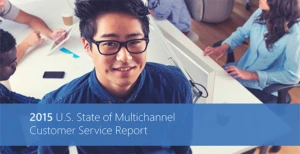
The 80s Called: They Want Their Customer Service Back
I’ve read a lot of customer service reports lately that show, in 2014, the telephone still remains the preferred customer service channel. The NICE Global Customer Experience Survey shows that 88% of more than 1,000 respondents still rate the telephone as their most-preferred channel. A 2014 State of Multichannel Customer Service Survey commissioned by Parature found a lesser, but similar bias, with 43% of 1,000 respondents favoring the phone.
Forrester Research polling also supports the same, with more than 7,000 respondents saying telephoning a live agent was their most-used customer service channel (73%), with self-service FAQs on a brand’s website coming in second at 67% followed by email, chat, click-to-call, communities, screen sharing, virtual agent, texting and social media.
Hold the Phone
So while we are left to read here that one of the oldest, most high-cost, high-touch channels available still rules the roost for customer service in the 21st century, we also need to read into this.
Do customers really long for conversation, to hear the instrumental version of Welcome to the Jungle or Wham’s Careless Whisper, or to tackle the ten-minute challenge of navigating an IVR to get to a live person? No. But what they are finding more times than not, when they call and eventually get to a live customer service representative is an answer, information or issue resolution following a frustrating attempt to find these things themselves online.
The Disconnection with the Connected Customer
Even though consumer adoption of lower-cost online channels such as self-service FAQs, live chat, and social media is up and continues to rise, satisfaction with these channels is not on the same steep climb. According to the NICE survey previously referenced:
- 60% rate speaking to a live rep via phone as the most satisfying service channel
- 44% rate an in-person visit as the second most satisfying channel
- 39% rate self-service via a brand or organization’s website as the most satisfying channel…
… and it goes significantly downhill from there: IVR (18%), email (9%), smartphone app (6%), live chat (8%), text message (2%), communities/forums (1%), social media (1%).
Most brands even admit they’re just not there yet. When asked about their ability to deliver a channel-agnostic capability for customers to get relevant information, on a scale of 1 to 5 (with 1 being not at all effective and 5 being extremely effective) only 3% of respondents rated themselves a 5 (December 2013 Global eBusiness And Channel Strategy Professional Online Survey – Forrester Research).
And the cost of failing to meet customer expectations for online/multichannel service is high: 75% of consumers move to another, higher-cost channel when online customer service fails, and Forrester Research estimates that unnecessary service costs to online retailers alone due to this failure are $22 million per year.
Back to the Future
Dude, the 80s called. They want their customer service back. Let’s accept the charges and return it promptly.
Making a telephone call should not be the most preferred, most used, most satisfying customer service channel of the 21st century. While we can’t go back in time, we’ve got a lot of tools, technology and best practices that can move us into the online/multichannel future our customers are waiting for.
…………………………………………
Learn Customers’ Great Expectations for Customer Service
 A new 2014 State of Multichannel Customer Service Survey commissioned by Parature, from Microsoft shows that old customer service channels certainly aren’t going away, but new ones like social are creating both greater and faster service expectations across the board.
A new 2014 State of Multichannel Customer Service Survey commissioned by Parature, from Microsoft shows that old customer service channels certainly aren’t going away, but new ones like social are creating both greater and faster service expectations across the board.
The survey, which gauged the responses of 1,000 U.S. consumers, shows that time and effectiveness are of the essence when it comes to a satisfying customer experience. Key findings are summarized in the accompanying infographic. To download and read the full survey report, click here.
(Photo Credit: Universal Studios)

